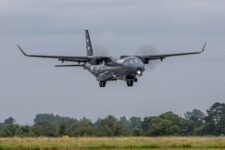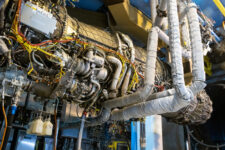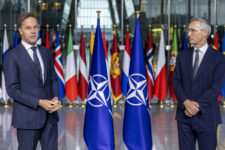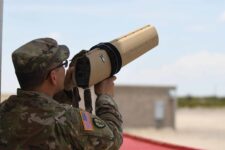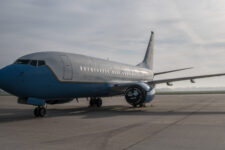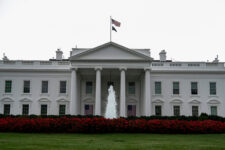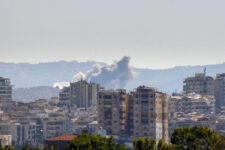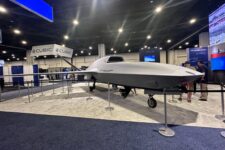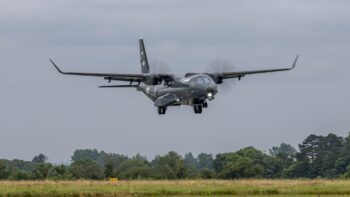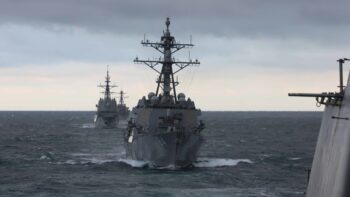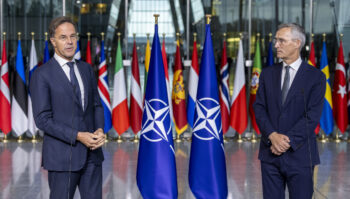
Finnis Marines prepare to board on a Swedish CB90-class fast assault craft ahead of an amphibious assault demonstration during the Nordic Response 24 military exercise on March 10, 2024, at sea near Sorstraumen, above the Arctic Circle in Norway. (Photo by Jonathan NACKSTRAND / AFP) (Photo by JONATHAN NACKSTRAND/AFP via Getty Images)
Ahead of the upcoming NATO Summit in Washington, Breaking Defense has collected exclusive opinion pieces from key defense officials along the alliance’s northern border — the Arctic, where Russia and China are increasingly active. Below, Commander of the Finnish Defense Forces Gen. Janne Jaakkola gives an overview of his nation’s military posture, a year after joining the alliance.
One of the most significant security policy knock-on effects of the war in Ukraine has been the accession of Finland and Sweden to NATO. The alliance grew by almost 788,800 square kilometers, and its land border with Russia became more than 1,300 kilometers longer. From the perspective of military capabilities, the memberships of Finland and Sweden provide an additional 344,000 soldiers, more than 1,000 artillery pieces, over 300 main battle tanks and more than 160 fighter jets to NATO´s wartime strength.
The new defense posture in the North changes the overall situation for NATO and its member states, but to really consider the benefits to the alliance, start by considering the geography, both in the Arctic and the Baltic. Remember: Excluding Russia, all the nations in the Arctic are part of NATO. Similarly, the states situated on the coast of the Baltic Sea all belong to NATO, Russia excluded.
That is no small thing, as in the prevailing security situation, the importance of the Arctic region is enhanced. With its natural resources and as a logistic sea line of communication the Western countries, Russia and also China all have interests in the area. Meanwhile, the Kola Peninsula, Greater St. Petersburg and the Kaliningrad region are areas of vital importance to Russia, with the Baltic Sea providing a crucial route for Russian maritime trade. The flows of goods to and from the regions of St. Petersburg and Moscow run through the ports of the Baltic Sea.
From a military-strategic perspective, the Baltic Sea Region, the North Atlantic and Finland’s neighboring Arctic areas are really one entity. Over 90 percent of Finland’s exports and imports travel by the maritime routes of the Baltic Sea. In practice, our country is an island, hence the stability of the Baltic Sea Region and freedom of the seas for maritime traffic are important for Finland.
The environment in Finland sets specific requirements for operations, troops and materiel. One must be able to operate in an area where logistics distances may turn out to be long and infrastructure sparsely situated.
Along those lines, Finland’s geography, weather, national defense solution and our history as one of Russia’s neighboring countries have steered the development of the Finnish Defence Forces in the long term. Even during the most peaceful times in the security environment, the possibility of a military conflict has not been ruled out. Finland maintains and develops a strong national defense capability that is based on general conscription and comprehensive defense as part of NATO’s collective deterrence and defense. This includes further cooperation with Allies and partners.
The Finnish Defence Forces is a combination of modern technology-based, high-end weapon systems and a large, competent reserve. However, materiel alone is not what makes effective defense; Competence and proficiency play a central role. Unlike many other Western countries, Finland has maintained conscription as a base for national defense, thus forming a large reserve — important capacity from the perspective of resilience and the ability to conduct operations on a larger scale and during longer lasting crises or conflicts.
Finnish wartime forces consist of 280,000 soldiers equipped and trained for operating in demanding Arctic and austere conditions. The Finnish Air Force is capable of operating in the sphere of influence of advanced intelligence, surveillance and weapon systems. The Navy is specialized in operating in a demanding coastal and littoral environment, including icy conditions in the winter.
This is our backyard, and we are here 365 days a year, 7 days a week, 24 hours a day.
Alliances, And The Finnish Society
Finland has been a full member of NATO for over a year now, during which we have worked to coordinate national defense plans with the alliance. But of course, we did not start from ground zero: The share of defense spending in the Finnish budget is 2.3 percent of GDP, crossing the NATO target. Materiel investments make up over half of the $5.91 billion defense budget — driven primarily by the ongoing procurement of the F-35.
While NATO’s possible future presence in Finland is still in the planning phase, Finnish personnel have been allocated to NATO’s command and force structure. Exercise Nordic Response 24, part of the Steadfast Defender effort, was conducted partially in Northern Finland. During the spring, a Finnish Navy vessel participated in the operations of the Standing NATO Mine Countermeasures Group in the Baltic Sea and the North Sea. Currently, during the summer of 2024, the Finnish Air Force is taking part in NATO’s Air Shielding mission with eight F-18´s in Romania, Bulgaria and the Black Sea.
Bilateral and multilateral defense cooperation enables a rapid and flexible implementation of NATO’s regional defense plans. Cooperation allows us to operate with flexibility and agility in all security situations. Regional cooperation is aimed at strengthening the deterrence and defense of the Alliance. Historically, of course, the Nordic countries have been an important reference group for Finland, as the geography, threats, risks and vulnerabilities are quite similar across the Nordic nations. But our defense cooperation with the United States is deepening, and Finland also actively participates in the UK-led JEF activities.
However, defending Finland is not just the role of the military, but rather a whole of society effort. The Finnish concept of comprehensive security is based on the coordinated use of all the assets of the society in a crisis situation, emphasized as the collective responsibility of the whole state and society. In a complex environment, many kinds of actions are needed to mitigate large-scale security risks. Finland’s strength has always resided in cooperation between the public sector, authorities, companies and communities.
Defense capability is a vital part of that preparedness. Logically, the aim is to ensure that resources and assets of society can be allocated to defense needs, if necessary. Industrial and service establishments are prepared to manage the manufacturing of goods critical to defense. Even in peacetime, the Finnish Defence Forces have a close partnership with several companies representing different types of business, which serve to ensure and strengthen our national security of supply. We also pursue close cooperation with the industrial sector to be able to take advantage of new and innovative technologies for defense needs.
The security situation in the world is uncertain and complex, and no improvement for this state of affairs is in sight in the near future. In all situations, we Finns will always have the main responsibility for defending our country. The national defense will of our citizens is at its highest during the history of the survey — 79 percent are willing to defend Finland, even if the outcome were to be uncertain. And 90 percent of Finnish citizens support our NATO membership.
This will and determination provides a good starting point for keeping the Northern dimension of NATO secure. At the same time, Finland is committed to tackling threats and challenges from any direction as part of the Alliance. Finland is a constructive, reliable and capable member of the Alliance and engages its Allies with a strong, active approach to security.
Gen. Janne Jaakkola is the Commander of the Finnish Defense Forces, having taken office in April of this year.

